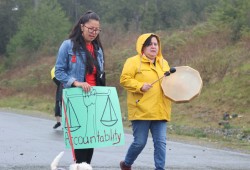Maxine Clutesi is 13 going on 14. The young Nuu-chah-nulth teen likes vintage fashion and jokes that the usual bout of coastal rain is flattening her classic 50s big hair.
She speaks the truth like only a teenager can.
“Personally, I’m not scared when I go out because I don’t look native. When I was younger, I can’t remember who told me, but they told me I was lucky to be pale because nothing bad will happen to me,” Clutesi says from inside the Mini Bighouse in Hitacu on May 5 during Red Dress Day, a day to honour Missing and Murdered Indigenous Women and Girls and Two-Spirited People (MMIWG2S).
A small group of supporters have come together to remember loved ones.
“I think about that sometimes,” Clutesi continues. “I’m kind of glad it might keep me safer, but I also want to look how I am.”
Her friend Bella Martin, who is sporting two beautiful Indian braids, briefly looks up from her phone when asked the same question — Do you feel safe going out?
“Not really,” Martin admits. “I just pray to the Ancestors and hope.”
“There has to be change,” Clutesi says. “Change… Any kind of change.”
The Indigenous girls know what they are up against. They know that the murder rate for Indigenous women is nearly six times higher than that for non-Indigenous women. They know that Indigenous women are far more likely to experience violence and they know that whenever they leave their community they could go missing.
Elder Geraldine Touchie expressed her frustration.
“It’s like we’re invisible, which is really disappointing and aggravating,” said Touchie. “I’m sorry to say it, but if we get a missing non-native, it’s all over the news, but we have a missing native, it’s swept aside. Our lives are just as valuable as non-natives and we have just as much to offer. We have the potential just like anybody else,”
In attempt to bridge the inequality, a national Red Dress Alert System is in the works. Like Amber Alerts, the Red Dress Alert System would notify the public when an Indigenous woman, girl or two-spirited person goes missing. The 2024 Federal Budget revealed a $1.3 million investment over a three-year period for the implementation of the Red Dress Alert.
Denise Halfyard is the coordinator of the Tears to Hope Society, an Indigenous-led organization focused on supporting the families of MMIWG2S. Her cousin Tamara Chapman disappeared around Prince Rupert along The Highway of Tears in 2005.
“Myself and my mom (Lorna Brown) were asked to go to Ottawa and speak on the Red Dress Alert,” said Halfyard after the Red Dress Day Memorial Walk in Hitacu. “We mentioned how it should be Indigenous-led and that it should be regional. It should be regional because us living here in Ucluelet, I can’t do anything about a woman who goes missing in Surrey.”
Halfyard, who is of Wet’suwet’en, Tsimshian and Gitxsan descent, also discussed the lack of cellphone reception in rural areas during her trip to Ottawa.
“There are so many spots on The Highway of Tears with no reception. Even here, between Port Alberni and the Junction, there is no service. If a Red Dress Alert did go out, we’re not going to get it until we hit the Junction or Port Alberni. There are still issues there,” she said, adding that despite its shortcomings, the Red Dress Alert initiative is still a big step in the right direction.
Ucluelet First Nation’s Dyllon Peter walked with the women and girls in Hitacu to honour his aunt Rose Paul who was brutally murdered by her boyfriend in 2015.
“It’s horrible. It’s something that needs to be more in the media,” said Peter about his Stolen Sisters. “Nobody really talks about it. It’s sad that nobody talks about it. It needs more attention. I’m not really sure what else to say.”












